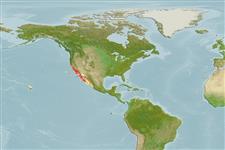Elasmobranchii (tubarões e raias) (sharks and rays) >
Carcharhiniformes (Ground sharks) >
Pentanchidae (Deepwater catsharks)
Etymology: Parmaturus: parma (L.), from parme (Gr.), small shield; oura (Gr.), tail, presumably referring to upper edge of caudal fin “armed with modified” scales (per Garman 1913) (See ETYFish); xaniurus: xanion (Gr.), comb for carding wool; oura (Gr.), tail, referring to crest-like row of tooth-like projections along upper edge of caudal fin (See ETYFish).
More on author: Gilbert.
Environment: milieu / climate zone / depth range / distribution range
Ecologia
marinhas batidemersal; intervalo de profundidade 88 - 1250 m (Ref. 96339). Subtropical; 39°N - 20°N
Eastern Central Pacific: central California, USA to the Gulf of California.
Comprimento de primeira maturação / Tamanho / Peso / Idade
Maturity: Lm 45.0, range 43 - 47.5 cm
Max length : 45.0 cm TL macho/indeterminado; (Ref. 244); 55.0 cm TL (female)
Found on the outer continental shelf and upper slope. Feeds on a variety of small fish (e.g. lanternfish) and invertebrates. Oviparous. Possesses an enlarged gill region which is an adaptation to areas with low dissolved oxygen levels. Has a high concentration of squalene in its liver which affords it neutral buoyancy. Regularly caught by bottom trawlers but not utilized at all.
Ciclo de vida ou comportamento de acasalamento
Maturidade | Reprodução | Desova | Ovos | Fecundidade | Larvas
Oviparous, paired eggs are laid. Embryos feed solely on yolk (Ref. 50449).
Compagno, L.J.V., 1984. FAO Species Catalogue. Vol. 4. Sharks of the world. An annotated and illustrated catalogue of shark species known to date. Part 2 - Carcharhiniformes. FAO Fish. Synop. 125(4/2):251-655. Rome: FAO. (Ref. 244)
Status na Lista Vermelha da UICN (Ref. 130435: Version 2024-1)
Ameaça para os humanos
Harmless
Uso pelos humanos
Pescarias: sem interesse
Ferramentas
Can't connect to MySQL database fbquizv2. Errorcode: Too many connections
